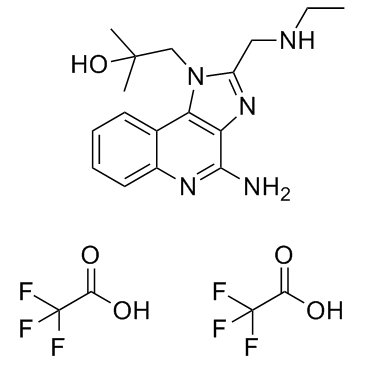| Description |
Gardiquimod trifluoroacetate is a specific TLR7 agonist which can also inhibit HIV-1 reverse transcriptase.
|
| Related Catalog |
|
| Target |
TLR7, HIV-1 reverse transcriptase[1]
|
| In Vitro |
Levels of HIV-1 DNA measured by real-time PCR are significantly lower in Gardiquimod trifluoroacetate-treated cells compare to untreated controls on day 9 postinfection. Significantly lower levels of HIV-1 DNA and HIV-1 p24 are observed in Gardiquimod trifluoroacetate-treated and HIV-1-exposed macrophages cocultured with activated PBMCs. Gardiquimod trifluoroacetate significantly increases IFN-α mRNA levels 80-, 20-, and 35-fold above the level of detection at 2, 4, and 6 h posttreatment, respectively[1]. The results show that treatment with Gardiquimod trifluoroacetate results in significant increases in expression of CD69 on T, NK and natural killer T (NKT) cells. It is also found that Gardiquimod trifluoroacetate stimulation increases mRNA expression of IL-12 p40 in RAW264.7 cells. Furthermore, Gardiquimod trifluoroacetate induces augmented secretion of IL-12 p70 into culture supernatant 48 and 72 h after treatment[2].
|
| In Vivo |
On day 12, the tumor volume in mice injected with PBS increases to 1770±370 mm3, whereas it is only 230±70 mm3 in mice treated with Gardiquimod trifluoroacetate[2].
|
| Cell Assay |
Peripheral blood cells (PBMCs) are resuspended at a concentration of 5×106 cells/mL in serum-free RPMI and added to large (150-cm2) tissue culture flasks to permit monocyte attachment. The cells are maintained in a humidified incubator at 37°C with 5% CO2 for a total of 8 days. On the fifth day of culture, the medium is refreshed and one-half of the cells are treated with 0.6 to 3.0 μM Gardiquimod trifluoroacetate for 3 days prior to infection with HIV-1 on day 8 of culture. Control macrophages are left untreated[1].
|
| Animal Admin |
Six- to eight-week-old C57BL/6 mice weighing 20 to 24 g are used in this study. For subcutaneous (s.c.) tumors, 5×104 B16 cells in 100 µL of PBS are injected s.c. into the right flank of C57BL/6 mice on day 0. Mice are vaccinated intravenously with 4×104 DCs on day 7 and peritumorally injected with 1 mg/kg Gardiquimod trifluoroacetate on days 8 and 10. Control mice are injected with an equivalent volume of PBS. Beginning on day 8, the tumor length and width are measured with a vernier caliper, and tumor volume is calculated as length×width2/2. The mice are killed on day 13, and tumors are excised and weighed[2].
|
| References |
[1]. Buitendijk M, et al. Gardiquimod: a Toll-like receptor-7 agonist that inhibits HIV type 1 infection of human macrophages and activated T cells. AIDS Res Hum Retroviruses. 2013 Jun;29(6):907-18. [2]. Ma F, et al. The TLR7 agonists imiquimod and gardiquimod improve DC-based immunotherapy for melanoma in mice. Cell Mol Immunol. 2010 Sep;7(5):381-8.
|
